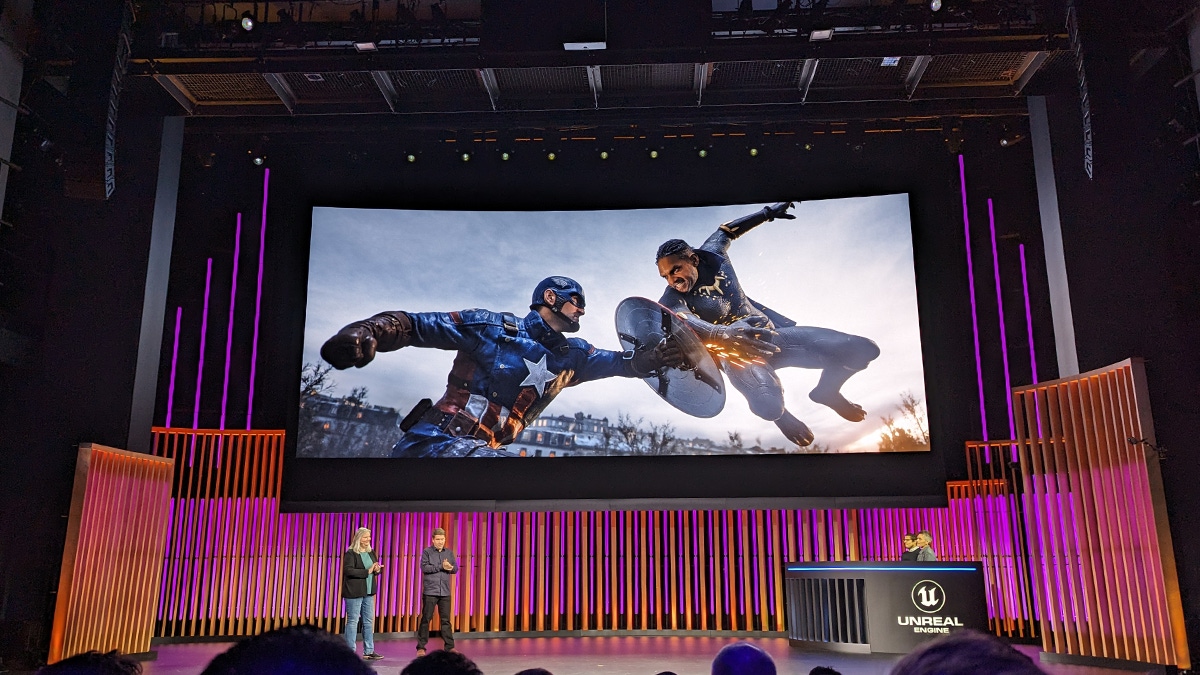Trending
Opinion: How will Project 2025 impact game developers?
The Heritage Foundation's manifesto for the possible next administration could do great harm to many, including large portions of the game development community.

Read More from GDC 2024 | Keep up with the latest game industry event coverage from GDC 2024, including news, talks, interviews, and more from the Game Developer team.
Fortnite development is moving to UEFN and Amy Hennig is leveraging UE 5.4 to bring to iconic Marvel characters to life.

For many attendees, I suspect the highlight of Epic's annual State of Unreal showcase was the bombastic reveal of Amy Hennig and Skydance's upcoming superhero adventure Marvel 1943: The Rise of Hydra. The extended trailer raised the roof at Blue Shield of California Theater, but it was the real-time tech demo after that truly stole the show.
Hennig showed the audience how Skydance has leveraged Unreal Engine 5.4 tools and features including Nanite and volumetric rendering to achieve rich visual fidelity and detail in scenes. The studio is leaning on Sparse Volume Textures to support animation and real-time streaming for minimum memory footprint, while Heterogenous Volumes render volumetric assets with cinematic quality and self-shadowing.
It's also using MetaHuman assets in combination with high-resolution 4D scans to capture and transform Marvel 1943's two lead actors into Captain America and Black Panther. During an on-stage virtual camera demo, Hennig also showed how directors can explore the digital world in search of the perfect shot using physical tech, all while virtual scenes are tweaked and edited directly in-engine.
It was an impressive opening that highlighted some of the most impactful changes coming with Unreal Engine 5.4. The update, which will land in late April, will introduce a number of rendering performance improvements (including major updates to Nanite), to let devs deliver greater visual fidelity without creating larger meshes on disk. UE 5.4 will also give animators a lift by introducing Motion Matching, a simple tool that can be used to animate characters in-game (and one that's currently being deployed in Fortnite on all platforms).
"Later this year we will also release a free sample learning project that includes over 500 AAA animations created from high-end motion capture data with the locomotion and traversal dataset used in the keynote demo. In addition, thanks to extensive battle-testing in LEGO Fortnite development, you can now fully animate your game using Control Rig and Sequencer with no round tripping between applications," said Epic, delivering its UE 5.4 roll call. "Multi-Process Cooking can now be up to three times faster, compiling far fewer shaders in the editor during cooks. There’s also good news for sound designers, who can use our new Audio Insights profiling tool to create, understand, and debug powerful next-gen audio.
The fully in-engine Procedural Content Generation (PCG) Framework has significant improvements, too. We're releasing a PCG Biome creation plugin as a concrete example of a flexible, data-driven tool built with a systemic approach featuring the latest updates."
Unreal Editor for Fortnite is celebrating its first birthday and Epic brought plenty of gifts. The company is bringing MetaHuman to UEFN from today, which means users will be able to easily create and animate lifelike NPCs for use on their Fortnite islands.
"MetaHuman Creator is a free online application that enables you to produce realistic digital humans that are fully rigged and ready to use in UEFN or Unreal Engine, in minutes," explained Epic, breaking down its MetaHuman tools for those who might not be in the know.
"MetaHuman Animator turns footage captured from an iPhone or stereo head-mounted camera into high-quality facial animation for your MetaHuman. Facial animation created using MetaHuman Animator can be applied to any MetaHuman or any Fortnite character available in UEFN."
The engine maker is also giving all UEFN creators the opportunity to claim a free one-year license of Marvelous Designer, which facilitates the creation of dynamic clothing using a new UE 5.4 workflow. This resplendent garb can then be imported into UEFN projects.
The deluge of announcements didn't stop there. Epic is making a selection of Fall Guys, LEGO, and Rocket Racing assets available to UEFN creators, including animations, templates, and Fall Guy's iconic beans. Epic said it wants to find more opportunities for creators to leverage both its own IP and licensed IP, suggesting there'll be more to come down the line.
Epic noted that UEFN creators have already made a combined $320 million since the toolkit launched, and have collectively created over 80,000 Fortnite islands.
In the long-term, the company believes UEFN will become more than capable of creating "triple-A content" and plans to show developers just how powerful UEFN has become by moving Fortnite development over to UEFN by 2025.
"We've always used our own first-party games to push Unreal Engine development forward and ensure it’s battle-tested for creators," said the company. "It's time for Fortnite development to move to UEFN and Verse. By the end of 2025, we will ship our first season of Battle Royale developed entirely in UEFN."
In the meantime, Epic will continue to expand UEFN's tools and capabilities by adding more camera and control systems (including the coveted first-person camera), a new itemization system, a new Scene Graph system that can be used to dynamically manipulate almost every in-game object, physics sandbox gameplay, and more.
You can hear more about all the announcements at State of Unreal 2024 over on the Unreal Engine blog.
Game Developer and GDC are sibling organizations under Informa Tech.
You May Also Like